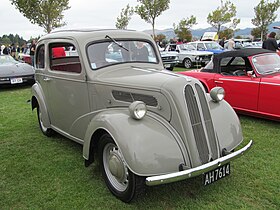Ford Popular
| Ford Popular | |
|---|---|

Ford Popular (103E)
|
|
| Overview | |
| Manufacturer | Ford UK |
| Production | 1953–1962 |
| Ford Popular 103E | |
|---|---|
 |
|
| Overview | |
| Production | 1953–1959 |
| Assembly | United Kingdom Australia |
| Body and chassis | |
| Body style | two door saloon two door coupe utility (Australia) chassis-cowl (Australia) |
| Related | Ford Anglia |
| Powertrain | |
| Engine | 1172 cc straight-4 side-valve 30 bhp |
| Transmission | 3-speed manual |
| Dimensions | |
| Wheelbase | 90 in (2,286 mm) |
| Length | 151.5 in (3,848 mm) |
| Width | 56.5 in (1,435 mm) |
| Height | 64.5 in (1,638 mm) |
| Curb weight | 1,624 lb (737 kg) |
| Chronology | |
| Successor | Ford Popular 100E |
| Ford Popular 100E | |
|---|---|
 |
|
| Overview | |
| Production | 1959–1962 |
| Body and chassis | |
| Body style | two door saloon |
| Related | Ford Anglia |
| Powertrain | |
| Engine | 1172 cc straight-4 side-valve |
| Transmission | 3 speed manual |
| Dimensions | |
| Wheelbase | 87 in (2,210 mm) |
| Length | 149.75 in (3,804 mm) |
| Width | 60.75 in (1,543 mm) |
| Height | 58.75 in (1,492 mm) |
| Curb weight | 1,708 lb (775 kg) |
| Chronology | |
| Predecessor | Ford Popular 103E |
| Successor | Ford Anglia |
The Ford Popular, often called the Ford Pop, is a car from Ford UK that was built in England between 1953 and 1962. When launched, it was Britain's lowest priced car.
The name Popular was also used by Ford to describe its 1930s Y Type model. The Popular name was also later used on basic models of the Escort and Fiesta cars.
Electrics were 6 volts, a provided starting handle often necessary. Rod operated drum brakes, synchromesh only on 2nd and top gear. The boot accessed with a coach key, no heater or demister, semaphore indicators, pull-wire starter, manual choke. No water pump, engine cooling by thermosyphon - this was very basic motoring.
When production of the older Ford Anglia and Ford Prefect was stopped in 1953 the Popular was developed as a budget alternative, based on the old, pre-war style E494A Anglia. The E494A was, in turn, a facelift of the Anglia E04A, which was a facelifted version of the 7Y, itself a rebodied Model Y. Thus through several adjustments, updates and name changes, a design with provenance dating back to 1932 was produced by Ford for 27 years. It was powered by a Ford Sidevalve 1172 cc, 30 bhp (22 kW), four-cylinder engine. The car was very basic. It had a single vacuum-powered wiper, no heater, vinyl trim, and very little chrome; even the bumpers were painted, and the bakelite dash of the Anglia was replaced by a flat steel panel. The Popular 103E differed visually from the Anglia E494E in having smaller headlights and a lack of trim on the side of the bonnet. Early 103Es had the three spoke banjo type Anglia/Prefect steering wheel as stocks of these were used up, but most have a two spoke wheel similar to the 100E wheel but in brown. Early Populars also had the single centrally mounted tail/stop-lamp of the Anglia, but this changed to a two tail/stop lamp set up with the lamps mounted on the mudguards and a separate number plate lamp. In total, 155,340 Popular E103s were produced.
This car proved successful because, while on paper it was a sensible alternative to a clean, late-model used car, in practice there were no clean late-model used cars available in postwar Britain owing to the six-year halt in production caused by the Second World War. This problem was compounded by stringent export quotas that made obtaining a new car in the late 1940s and into the early 1950s difficult, and covenants forbidding new-car buyers from selling for up to three years after delivery. Unless the purchaser could pay the extra £100 or so for an Anglia 100E, Austin A30 or Morris Minor, the choice was the Popular or a pre-war car.
...
Wikipedia
